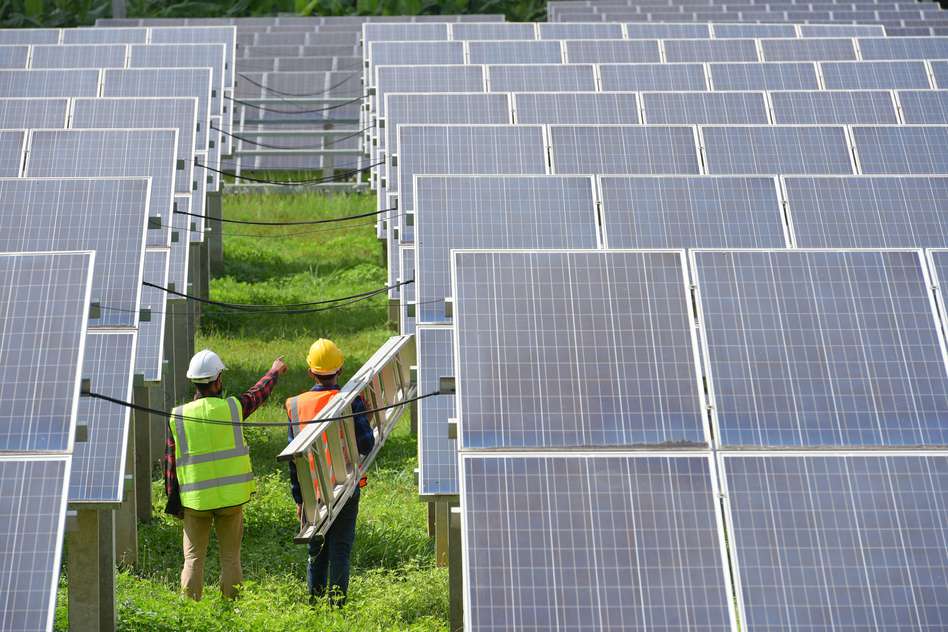Considering leasing your land for a solar farm project?

Solar farms are one of the fast-growing renewable energy initiatives which are springing up across the country. Solar developers are constantly looking for land to build new solar projects on, so if you are a landowner with some unused land, this gives you the opportunity to lease your land and diversify your income, usually by way of a rental income over a fixed period of years.
Solar farms, also known as solar fields or solar parks, are the large-scale application of solar photovoltaic (PV) panels to generate green, clean electricity at scale, usually to feed into the national grid. Solar farms can cover anything between 1 acre and 250 acres and are usually developed in rural areas.
Approximately 25 acres of land are required for every 5 megawatts (MW) of installation – see our checklist below to find out if your land may be suitable.
As well as providing you with an additional income stream, there are a host of other environmental benefits associated with solar farms. Embracing solar farms as part of your land diversification strategy contributes to a sustainable and prosperous future both for you, your family and society as a whole.
What are the benefits of solar farm land diversification?
- Stable income - leasing or selling the land for solar farm development provides an increased, diversified and stable source of income for you as a landowner. This can enable financial security and potential long-term revenue streams.
- Reversible land use – solar farms represent a time-limited, reversible land use option for landowners. Unlike permanent infrastructure, such as buildings or roads, solar farms can be decommissioned relatively easily, allowing the land to be repurposed for other agricultural or developmental activities in the future.
- Efficient use of land – one of the remarkable aspects of solar farms is their ability to generate substantial electricity while occupying a relatively small portion of land. For instance, installing 10,000 megawatts (MW) of solar capacity on the ground in the UK would only utilize 0.1% of the country’s agricultural land area. Despite occupying a small fraction of available land, this solar capacity could generate enough electricity to power over 3 million homes. This efficient land utilisation allows for the coexistence of agricultural activities alongside renewable energy generation.
- Significant energy generation and carbon reduction – solar farms have a significant impact on energy production and carbon reduction. With every 5 MW of installed capacity, a solar farm can annually power more than 1,500 homes. Considering the average annual household electricity consumption of 3,300 kWh, this represents a substantial contribution to meeting energy demands. Moreover, the environmental benefits of solar farms are evident in the reduction of carbon dioxide (CO2) emissions. A solar farm with a 50 MW installation can save approximately 21,500 tonnes of CO2 annually, contributing to mitigating climate change and improving air quality.
- Grid resilience and energy independence - distributed solar farms across various locations contribute to grid resilience and energy independence. By decentralizing energy generation, solar farms reduce the dependence on a single centralized power source, minimizing the risk of widespread outages. In cases of extreme weather events or natural disasters, solar farms can continue to generate electricity, providing essential power supplies to nearby communities. This resilience helps ensure a stable and reliable energy infrastructure.
- Land conservation and biodiversity promotion: solar farm land diversification can be designed to incorporate conservation measures, supporting local ecosystems and biodiversity. By implementing pollinator-friendly vegetation, such as wildflowers or native grasses, solar farms can serve as habitats for bees, butterflies, and other beneficial insects. These efforts contribute to the preservation and restoration of wildlife populations, enhancing biodiversity in the surrounding areas. Additionally, by preventing agricultural land from being converted into urban or industrial areas, solar farms can play a role in conserving valuable natural resources.
- Community and economic development: Solar farms can have a positive impact on local communities by fostering economic development. During the construction phase, solar farms create job opportunities, providing employment for local workers and boosting the local economy. Furthermore, solar farms can establish partnerships with neighbouring communities, supporting educational initiatives, renewable energy awareness campaigns, and community-based projects. This collaboration promotes a sense of ownership and involvement in the transition to clean energy, creating a more sustainable future.
Is my land suitable for a solar farm?
This checklist gives a guide as to the likely suitability of your land for a solar farm project and things you should consider:
- Is the land flat? If not, what is its gradient and orientation? The incline of the proposed land impacts the ease of building and access.
- Is there access to the site? Roads and paths will be essential for construction vehicles and crews to enter and exit the construction site. As part of the solar project, the developer may wish to install accessways or enlarge what is already there.
- Is the ground rocky? How deep is the topsoil? Rocky ground may be more challenging to build on or insert ground mounts into. Topsoil depth also affects the structural stability of foundations.
- Is the proposed location of the solar panels in an Area of Outstanding Natural Beauty (AONB) or a national park? It is unlikely that a solar farm will receive planning consent if it is located within either of these two categories of land.
- Can the field be seen from a road? If the site is visible from the road there may be additional planning considerations due to the perceived impact on the visual amenity of the area which refers to the views and surroundings that comprise the backdrop to an area.
- Is there any substantial energy consumption on the premises? You need to factor in whether the proposed solar farm is being considered for powering and offsetting the electricity bills of commercial premises.
- Where is the nearest substation/power connection? Proximity to a substation or power connector is desirable because voltage drop/power losses through power cables increase with distance. The size of the power line is also important: a 33kVa line or above is ideal, however 11kVa lines are also suitable. A developer will need rights to install cabling under your land (and potentially under neighbouring land). In addition, they may well need rights to allow the installation of a new substation on your land.
- Is there any existing solar PV installed on the property currently? Installing a new system on a property where one already exists may have an impact on the feed-in tariff eligibility of the first system. Additional electrical connection considerations will also apply to a second system.
- Are there any substantial solar PV or wind farm installations nearby? Receiving permission to connect to the grid may depend on the state of the network in the region of the proposed installation. An already high penetration of solar power or wind (both types of ‘distributed generation’) may affect the ease of granting a grid connection permission.
How does the leasing on a solar farm work?
As a landowner, typically you will receive rental income on the leased land, in exchange for a rental income for a fixed number of years – usually around 30 years. Rental payments are index-linked, rising annually with inflation and made in advance from the point at which construction of the site begins.
How Tees can help
The experienced renewable energy team at Tees can advise both developers and landowners at every stage of the property aspects of a solar project. This includes all stages from the early lease negotiations, through to helping secure funding and offering ongoing assistance with the operation of the solar site throughout the term of the lease.
Call our specialist solicitors on 0808 231 1320
We have many specialist lawyers who are based in:
Cambridgeshire: Cambridge
Essex: Brentwood, Chelmsford, and Saffron Walden
Hertfordshire: Bishop's Stortford and Royston
But we can help you wherever you are in England and Wales.
Chat to the Author, Alexander Waples
Senior Associate, Commercial Property, Cambridge office
Meet Alexander
- Areas of expertise
- Accreditations
- Testimonials
Legal 500 UK 2025 - Agriculture & Estates
East Anglia
Alex Waples also goes the extra mile, his expertise shines through. We know that his advice is always cost-effective. We cannot fault the service.
Legal 500 UK 2025 - Agriculture & Estates
East Anglia
I have worked with Alex Waples on a number of matters both in relation to agriculture and estate matters as well as in relation to renewable energy projects. He has always been very knowledgeable, approachable and efficient in advising our mutual clients.
Legal 500 UK 2025 - Agriculture & Estates
East Anglia
Alex Waples is helpful, easy to contact and gives good advice. Good knowledge of all areas of agriculture and able to help in a wide range of situations- nothing is too small attitude which is appreciated by mutual clients.
Legal 500 UK 2025 - Agriculture & Estates
East Anglia
We have received superb service from Alex Waples.
Legal 500 UK 2025 - Agriculture & Estates
East Anglia
Alexander Waples has been invaluable, he has offered advice and negotiated on our behalf. He responds quickly and efficiently.
Legal 500 UK 2025
East Anglia - Cambridge
Alex Waples has wide knowledge of the law at stake, he is prepared to tackle extremely difficult issues head on, and has a great sense of humour which is needed when things get awkward.
Legal 500 UK 2024
East Anglia, Cambridge
99% of my contact is with Alex Waples. He is always very quick to respond, very knowledgable, very professional and very approachable.
Legal 500 UK 2024
East Anglia, Cambridge
Alexander Waples is highly recommended by us for his professionalism, approach, knowledge and technical aptitude – a safe pair of hands.
Legal 500 UK 2024
East Anglia, Cambridge
Alex Waples is a pleasure to work with. He has a keen eye for detail and explains matters in a comprehensive manner for all parties involved. Importantly, Alex takes a commercial view and holistic approach which allows for a smooth transaction. We really value the ability to speak directly with Alex in order to gauge a feel and also understand certain scenarios which is very much welcome.
Legal 500 UK 2023
'Alexander Waples – Alex was very professional and approachable. He quickly understood our position and what we needed going forward. We found his advice to be very effective and efficient. His advice is also so on point and thinking ahead'
Legal 500 UK 2023
'Alex Waples brings a practical knowledge of the dynastic issues within a family farming business when advising on complex legal matters. Ian Johnston offers a relaxed and reassuring approach to problems. One senses that any problem he will have encountered and dealt with in a previous case. Daniel Fairs is a go to player when property is involved'
Legal 500 UK 2023
'Above all, Alex Waples’ unwavering can-do attitude makes him stand out in his field. Alex is able to accommodate time timescales when necessary and provides detailed commercial advice in a way which is easy to understand and gets straight to the crux of the issue whilst ensuring that he is protecting our interests at all times. Alex maintains a great working relationship with his clients through his effective communication and speedy responses – he is an essential and much valued part of our business'





